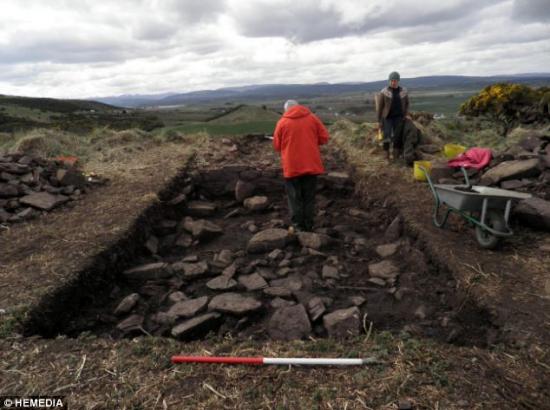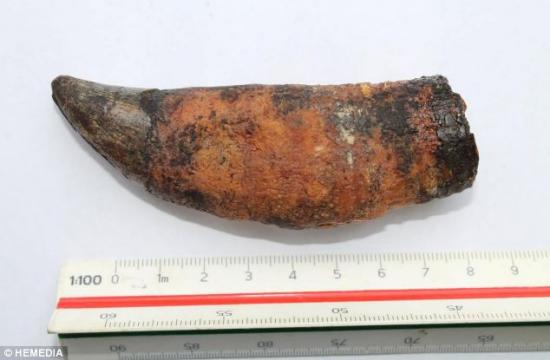Ellie Zolfagharifard
Source - http://www.dailymail.co.uk/sciencetech/article-2660382/Lives-painted-people-unearthed-Archaeologists-want-help-dig-Scotlands-ancient-Pictish-kingdom.html
-
Moray Firth in Northern Highlands was a powerful area for the Picts
-
Picts lived in the region during the Late Iron Age and Early Medieval Period
-
Archaeologists are hoping public will help them find remnants of the tribes
-
Excavations have already uncovered a whale tooth and a preserved brooch

A team of archaeologists from the University of Aberdeen have been digging in the Pictish heartland for 18 months. Key areas include Cnoc Tigh and Tarlogie Dun
 Moray Firth (pictured)- and the Tarbat Peninsula in particular - was the most powerful area for the Picts, who were known as the 'Painted People' by the Romans
Moray Firth (pictured)- and the Tarbat Peninsula in particular - was the most powerful area for the Picts, who were known as the 'Painted People' by the Romans
Easter Ross, a region in Scotland’s Northern highlands, is thought to have been a major heartland for the Pictish civilisation.
Archaeologists have found mounting evidence of their extensive occupation with recent excavations uncovering a whale tooth and a preserved brooch.
It is now thought that the Moray Firth region- and the Tarbat Peninsula in particular - was the most powerful centre for the Picts, who were known as the ‘Painted People’ by the Romans.

Archaeologists at work on the Rariche site in Easter Ross. Parts of the Highland area are now being recognised as a major centre of the Pictish civilisation as more and more evidence of their extensive occupation is found
Now a team of archaeologists from the University of Aberdeen, who have been digging in the area for 18 months, are encouraging locals to join in the excavation.
Dr Gordon Noble, a senior lecturer at the University of Aberdeen, is leading the project and says the team has found a range of interesting items indicating the resourcefulness of the Picts.
‘It’s been quite a revelation,’ he said. ‘We have funding for an initial four-year phase and already we’re starting to find quite an extensive northern Pictish kingdom.’
‘At Tarlogie Dun we made quite a few interesting discoveries dating back to around the 4th Century AD among the foundations of a roundhouse building.

The excavation of Easter Ross has already uncovered a whale tooth (pictured) and a preserved brooch, with researchers expecting further finds

Hand-coloured engraving of a Pictish woman warrior

Mel Gibson's blue face paint in Braveheart is a nod to the Pictish tradition of body-paint - but the real Picts fought stark naked, and there are records of them doing so up until the 5th Century
‘We found a well-preserved brooch, quite a few animal bones and a particularly interesting object which was a whale’s tooth.
‘It’s most likely that it came from a whale which beached somewhere nearby, which would be quite a sight for these people.
‘But it looks as if they have used the tooth as a tool, which suggests that they will have stripped it further and made maximum use of what they found.’
Mel Gibson's blue face paint in Braveheart is a nod to the Pictish tradition of body-paint - but the real Picts fought stark naked, and there are records of them doing so up until the 5th Century.
The Roman name for the people - Picti - means 'painted people'. It's not known what they called themselves.
The habit of fighting naked, especially in the cold Scottish climate, didn't harm the tribe's reputation for ferocity.
Picts held the territory north of the Firth of Forth in Scotland - and were one of the reasons even heavily armoured Roman legions could not conquer the area.
The picts repelled the conquests of both Romans and Angles, creating a north-south divide on the British Isles. However, the disappeared from history by the end of the first millennium.
Scottish placenames starting with ‘Pit’ - for example Pitlochry, Pittenweem and Pitsligo - retain a flavour of the language of the Picts that was borrowed by later people. ‘Pit’ is thought to mean a ‘share’ or piece of land
A recently discovered DNA marker suggests that 10 per cent of Scottish men are directly descended from the Picts
A number of workshops will be held to introduce basic archaeology to people who want to take part in the dig in the Highlands.
Open days will take place on June 29 at Cnoc Tigh, near Portmahomack, and at Tarlogie Dun, outside the Glenmorangie Distillery at Tain on July 20 which are sites of former settlements uncovered by archaeologists.